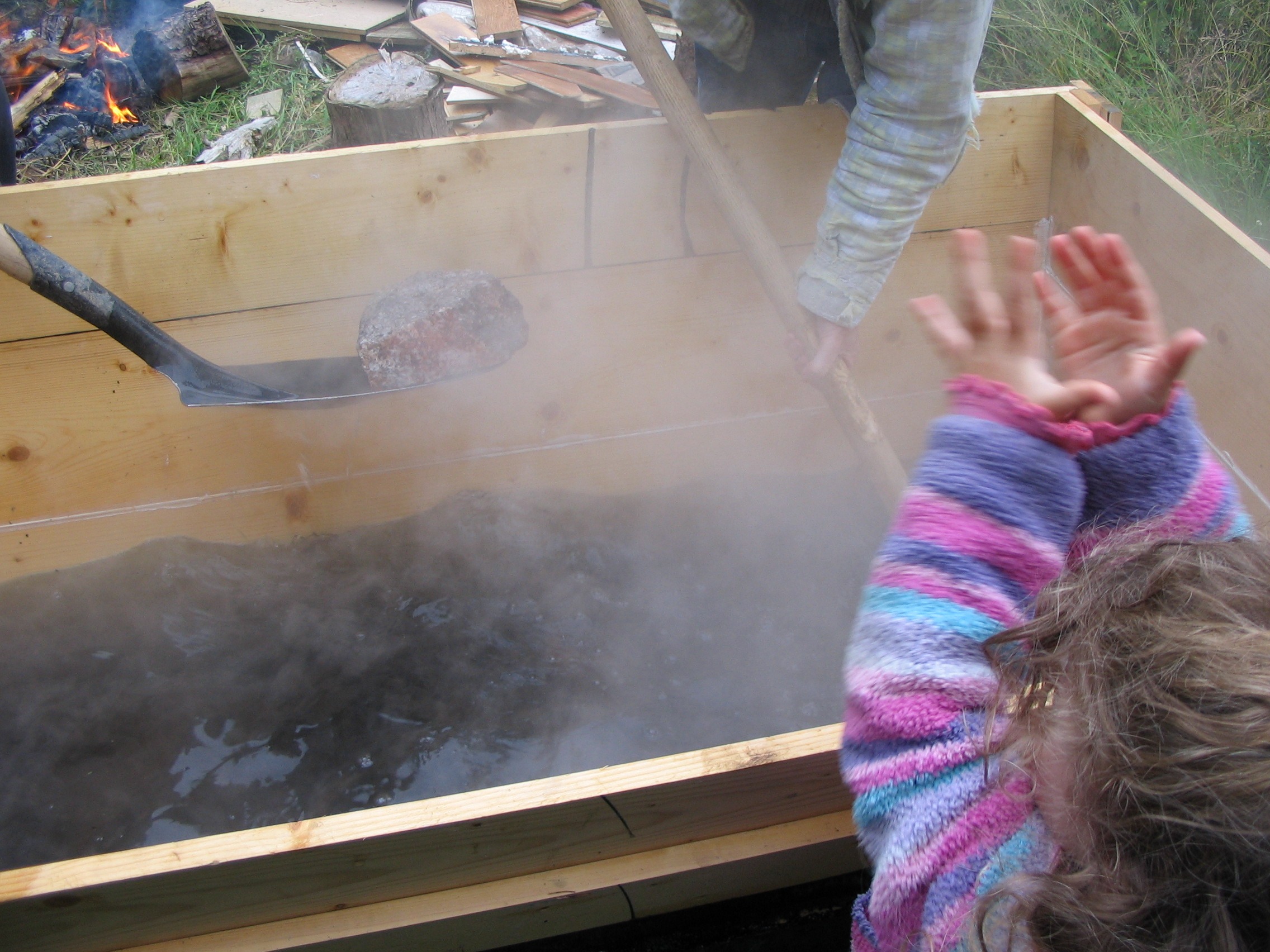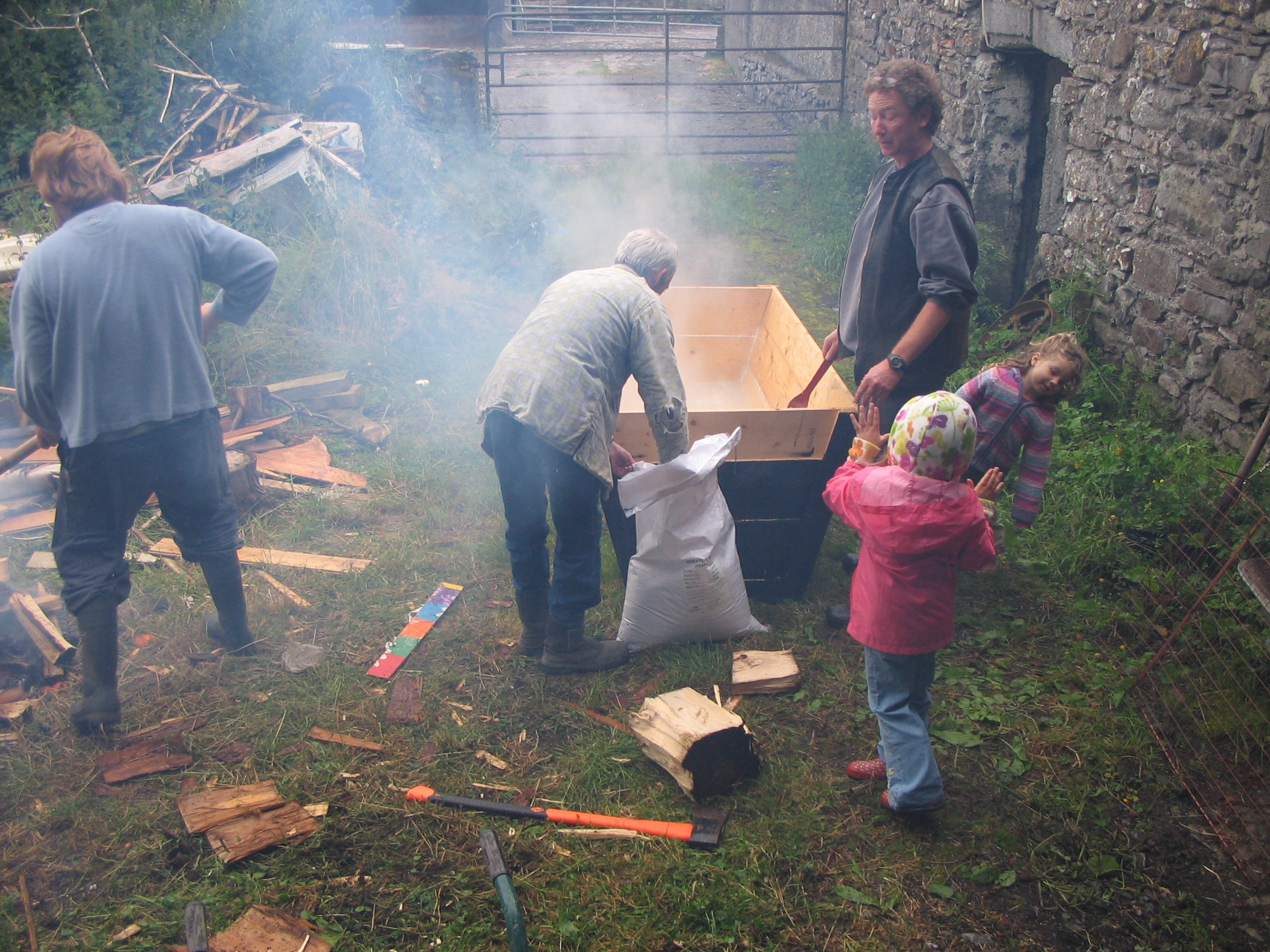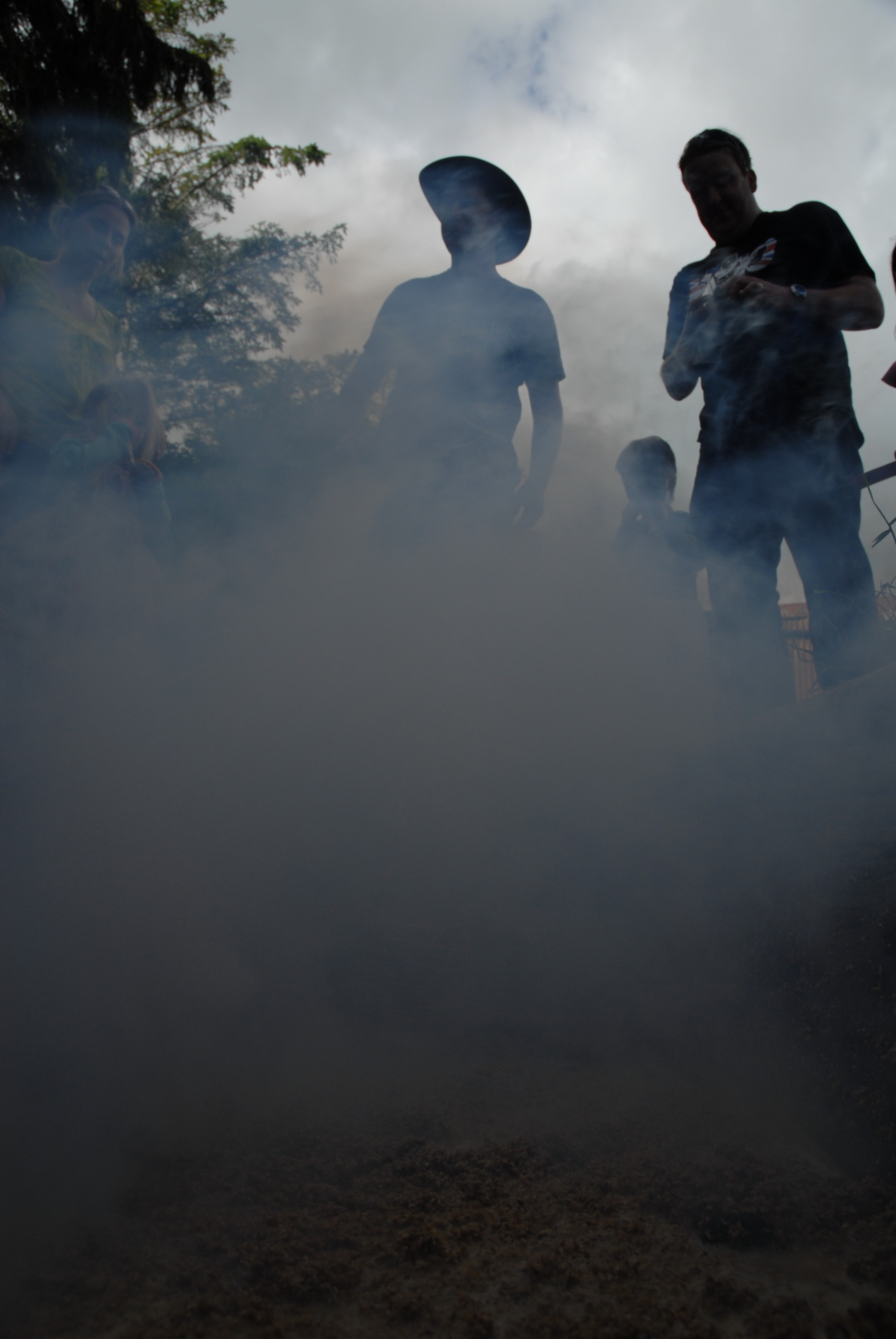Dining and Dwelling Part 3
Part three of Dining and Dwelling publication (Part one here, and part two here)
Our first brewing experiment was carried out at Billy’s home in Headford, Co. Galway, in August 2007. In an effort to make the experiment authentic the equipment had to be basic. For the mash tun we used an old, leaky, wooden cattle trough that measured 1.7 m in length, 0.7 m in width with a depth of 0.65 m (roughly consistent with the average trough dimensions from excavated fulachta fiadh). To make the trough watertight the seams were caulked with moss, a technique used by Bronze Age boat builders. The trough was then lowered into a ready-made pit and the edges backfilled. Water was then added. Despite some initial leakage the water in the trough eventually reached a natural level by simply flooding the immediate area. When filled to a depth of 0.55 m, the trough held 350 litres.
In choosing the stones for heating we consciously avoided limestone, as most fulachta fiadh are made up of non-limestone material. As O’Kelly (1954,122) observed, heated limestone on contact with water turns to calcium hydroxide, known as ‘milk of lime’, and is dangerous to ingest. Interestingly, during the excavations at Dún Aenghus on the Aran Islands, which geologically is a natural extension of the Burren, a trough was discovered with burnt granite cobbles scattered roundabout (Cotter 1993, P.13). Given the lack of granite on the island these ancient people obviously went to a lot of trouble to source this stone either by breaking up glacial erratics or travelling by boat to south Connemara. For the purposes of our experiment we used a mix of granite and sandstone from Clonbur, Co. Galway.
For our Bronze Age brewer stage one in the process after harvesting and winnowing the barley crop, would have involved artificially promoting growth by placing the grain in a textile bag or perforated leather container within a stream, allowing the grains to saturate and swell. This would result in the growth of a sprout or ‘acrospire’, visible as a rootlet at the base of the grain. At this point the grain is stunted by drying and rolling the grain in hot stones to make a starch-rich, roasted malted barley. The malt is then ready for grinding. In prehistoric times this would have been done with a saddle or rotary quern (grain which has been malted is far more suitable for grinding than unmalted grain that would still have a water content). Our malted barley (50 kg) was provided by Aidan Murphy, a master brewer with the Galway Hooker Brewing Company. The barley arrived unmilled and for reasons of convenience and expediency we crushed it using an electrical food processor. Aidan also supplied us with wet yeast from his brewery. If time permitted we could have made a simple yeast by kneading a hole in some dough adding water and leaving it exposed resulting in the formation of a yeast cake. However, yeast is notoriously volatile and we were content to use a known species.

Hot Stones
These ancient ‘wild’ beers would have been spontaneously fermented by particular combinations of local wild yeasts and micro-organisms as well as local plant and herb flavourings. In all likelihood they may have been somewhat tart, sour and acidic in taste, more like the Lambic beers of Belgium or contemporary Flanders red brown ales (Sparrow 2005, 5).
Echoing the role of air borne yeast the Norse sagas have it that Odin (the chief god in Norse paganism), disguised himself as an eagle and spilled the secret of beer from the sky. Furthermore, in Scandinavia and the Orkneys there is a tradition that early brewers realising that by reusing a stick they had stirred previous brews with, they could activate fermentation in subsequent worts, such sticks became valued items and it was not uncommon for them to be willed from one generation to the next. One can imagine that in prehistoric times these ‘wands’ impregnated with living yeast cells would have been invested with a spiritual potency. Indeed, a shaman or druid using the transformative powers of these ‘wands’ could be likened to Christ at Cana changing the water into wine.
To begin brewing our prehistoric beer, stones were heated in a wood fire for roughly two hours until superheated before being transferred into the water trough. After 15–20 minutes we achieved our optimum temperature of 60–70°C. This temperature can be identified by observing the surface of the water. As the water heats it becomes thinner and gently steams becoming glassy and mirror still. The ideal temperature is when the reflection is clearest. At this point we half submerged a wicker basket in the trough and began adding our barley and stirring it vigorously. Over a period of 45 minutes, maintaining a fairly constant temperature with the addition of occasional heated stones, our water transformed into a sweet smelling, syrupy wort. Even at this stage the nutritional value of the beverage was obvious. If we had decided to add milk, the resultant concoction would be similar to modern-day Horlicks or could have been served as gruel.

Heating the water
After completing the conversion of starches to sugar, ascertained by tasting the wort, we brought the mixture to a boil and then decanted it into fermentation vessels. We used plastic containers with a total capacity of 75 litres. In later experiments we used two Bronze Age replica urn-style pottery vessels, each with a capacity of 30 litres. The containers were then cooled in a bath of cold water before we added 350 ml of wet yeast. To counter the sweetness of the wort and lend the beer a more recognisable bitter taste we added seasonal flavourings sourced near Billy’s house. These included sprigs of bog myrtle, juniper berries and yarrow wrapped in muslin and suspended into the wort. Within eight to nine hours after cooling, the wort audibly began to bubble. Fermentation took place over the course of a week before the beer was ready for bottling. The end result was a relatively clear, copper-coloured brew with a sharp, yet sweet , taste. The hot rocks had imparted a slightly smoky caramelised flavour making it eminently drinkable. Friends and family likened it to wheat beer and compared it favourably to home kit brews.

Optimum temperature
Our beer could best be described as a gruit ale, an old-fashioned herb mixture used for bittering and flavoring beer, popular before the extensive use of hops.
We discovered that the process of brewing beer in a fulacht fiadh using hot-rock technology was entirely feasible. The production took only a few hours, followed by a week allowing for fermentation. Three hundred litres of water was transformed into a very palatable 110 litres of ale with minimal effort. The spent grain provided the ingredients for a dozen malt loaves and the rest was used as cattle fodder. Other than the shattered stone and the remains of the fire, there was little detritus.
NEXT POST: CONCLUSION AND BIBLIOGRAPHY
This entry was posted on Friday, September 18th, 2009 at 1:48 pm. It is filed under About Archaeology, About the Beer, Fulacht fiadh and tagged with ancient beer, Dining and dwelling, Fulacht fiadh, National Roads Authority, NRA.
You can follow any responses to this entry through the RSS 2.0 feed.





